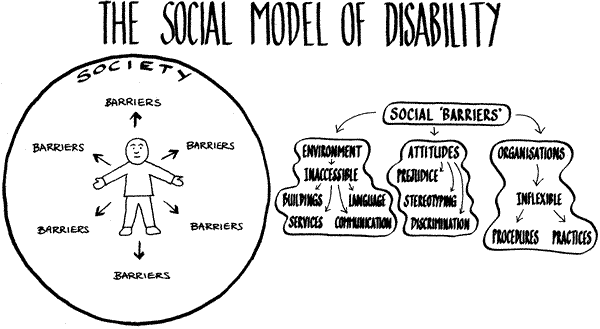> home | aims | attitudes | how to |
attitudes > medical | social | language | dda |
> conclusions | acknowledgements |
![[Taxi Training project logo]](images/logo-taxi.gif)
| TAXI DRIVER TRAINING
PACK > home | aims | attitudes | how to | attitudes > medical | social | language | dda | > conclusions | acknowledgements | |
![[Taxi Training project logo]](images/logo-taxi.gif) |
Disabled people have arrived at a different model to help understand the situation. They are challenging people to give up the idea that disability is a medical problem requiring "treatment", but to understand instead that disability is a problem of exclusion from ordinary life.
 |
| You will notice that compared to the medical model, the arrows on the social model are moving outwards. The items around the world are being addressed, and better facilities are slowly being provided for disabled people, but this is not happening fast enough because not enough people are aware of the problems that disabled people face. |
This is what is known as the "social model" of disability, requiring a change in society's values and practices in order to remove the barriers to participation that result in discrimination against disabled people. It is clear that this is possible and does happen, e.g. changing steps into ramps, providing information in Braille and other formats, providing textphones or minicoms, valuing different learning styles.
The social model does not deny the existence of impairments that may affect disabled people's daily lives, but is shifts the emphasis onto the real barriers which affect participation.
The social model of disability demonstrates that removing barriers for disabled people benefits everyone. This happens for example, by making the built environment more accessible (thus assisting parents with buggies, people with heavy luggage, older people etc); or providing more accessible information (plain, jargon-free language clear typefaces and layouts or other methods of communicating information). This assists a wide variety of people.
The social model locates the "problem" outside the disabled person and therefore offers a more positive approach because:
One of the causes of continuing prejudice is the language sometimes used, and we go on to look at this.
The text of this and the previous 2 pages is adapted from the Disability Rights Commission: Disability Discrimination Act - Best Practice Trainers Resource Pack 2002.